
Thyreophora is a group of armored ornithischian dinosaurs that lived from the Early Jurassic until the end of the Cretaceous.

Ankylosauria is a group of herbivorous dinosaurs of the clade Ornithischia. It includes the great majority of dinosaurs with armor in the form of bony osteoderms, similar to turtles. Ankylosaurs were bulky quadrupeds, with short, powerful limbs. They are known to have first appeared in the Middle Jurassic, and persisted until the end of the Cretaceous Period. The two main families of Ankylosaurs, Nodosauridae and Ankylosauridae are primarily known from the Northern Hemisphere, but the more basal Parankylosauria are known from southern Gondwana during the Cretaceous.

Animantarx is a genus of nodosaurid ankylosaurian dinosaur from the Early and Late Cretaceous of western North America. Like other nodosaurs, it would have been a slow-moving quadrupedal herbivore covered in heavy armor scutes, but without a tail club. The skull measures approximately 25 cm in length, suggesting the animal as a whole was no more than 3 meters long.

Edmontonia is a genus of panoplosaurin nodosaurid dinosaur from the Late Cretaceous Period. It is part of the Nodosauridae, a family within Ankylosauria. It is named after the Edmonton Formation, the unit of rock where it was found.

Gastonia is a genus of herbivorous ankylosaurian dinosaur from the Early Cretaceous of North America, around 139 to 134.6 million years ago. It is often considered a nodosaurid closely related to Polacanthus. Gastonia has a sacral shield and large shoulder spikes.
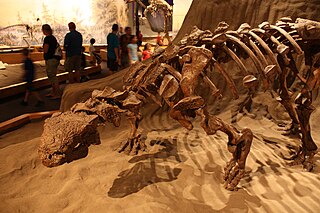
Ankylosauridae is a family of armored dinosaurs within Ankylosauria, and is the sister group to Nodosauridae. The oldest known Ankylosaurids date to around 122 million years ago and went extinct 66 million years ago during the Cretaceous–Paleogene extinction event. These animals were mainly herbivorous and were obligate quadrupeds, with leaf-shaped teeth and robust, scute-covered bodies. Ankylosaurids possess a distinctly domed and short snout, wedge-shaped osteoderms on their skull, scutes along their torso, and a tail club.

Struthiosaurus is a genus of nodosaurid dinosaurs, from the Late Cretaceous period (Santonian-Maastrichtian) of Austria, Romania, France and Hungary in Europe. It was a small dinosaur, measuring 2–3 m (6.6–9.8 ft) in length and weighing 300–400 kg (660–880 lb).

Aletopelta is a monospecific genus of basal ankylosaurid dinosaur from Southern California that lived during the Late Cretaceous in what is now the Point Loma Formation. The type and only species, Aletopelta coombsi, is known from a partial skeleton preserving osteoderms. It was originally described in 1996 by W. P. Coombs, Jr. and T.A. Deméré before being named in 2001 by Tracy Ford and James Kirkland. Aletopelta has an estimated size of 5 metres and weight of 2 tonnes. The holotype formed a miniature reef and was scavenged upon by invertebrates and sharks.
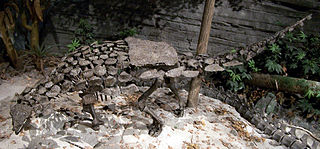
Nodosauridae is a family of ankylosaurian dinosaurs, from the Late Jurassic to the Late Cretaceous period in what is now North America, South America, Europe, and Asia.

Stegopelta is a genus of struthiosaurin nodosaurid dinosaur. It is based on a partial skeleton from the latest Albian-earliest Cenomanian-age Lower and Upper Cretaceous Belle Fourche Member of the Frontier Formation of Fremont County, Wyoming, USA.
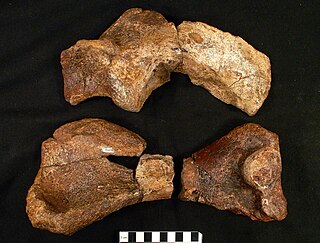
Texasetes is a genus of ankylosaurian dinosaurs from the late Lower Cretaceous of North America. This poorly known genus has been recovered from the Paw Paw Formation near Haslet, Tarrant County, Texas, which has also produced the nodosaurid ankylosaur Pawpawsaurus.

Mymoorapelta is a nodosaurid ankylosaur from the Late Jurassic Morrison Formation of western Colorado and central Utah, USA. The animal is known from a single species, Mymoorapelta maysi, and few specimens are known. The most complete specimen is the holotype individual from the Mygatt-Moore Quarry, which includes osteoderms, a partial skull, vertebrae, and other bones. It was initially described by James Kirkland and Kenneth Carpenter in 1994. Along with Gargoyleosaurus, it is one of the earliest known nodosaurids.

Stegosauria is a group of herbivorous ornithischian dinosaurs that lived during the Jurassic and early Cretaceous periods. Stegosaurian fossils have been found mostly in the Northern Hemisphere, predominantly in what is now North America, Europe, Africa, South America and Asia. Their geographical origins are unclear; the earliest unequivocal stegosaurian, Bashanosaurus primitivus, was found in the Bathonian Shaximiao Formation of China.
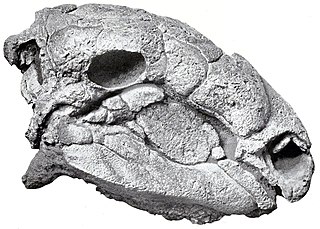
Panoplosaurus is a genus of armoured dinosaur from the Late Cretaceous of Alberta, Canada. Few specimens of the genus are known, all from the middle Campanian of the Dinosaur Park Formation, roughly 76 to 75 million years ago. It was first discovered in 1917, and named in 1919 by Lawrence Lambe, named for its extensive armour, meaning "well-armoured lizard". Panoplosaurus has at times been considered the proper name for material otherwise referred to as Edmontonia, complicating its phylogenetic and ecological interpretations, at one point being considered to have existed across Alberta, New Mexico and Texas, with specimens in institutions from Canada and the United States. The skull and skeleton of Panoplosaurus are similar to its relatives, but have a few significant differences, such as the lumpy form of the skull osteoderms, a completely fused shoulder blade, and regularly shaped plates on its neck and body lacking prominent spines. It was a quadrupedal animal, roughly 5 m (16 ft) long and 1,600 kg (3,500 lb) in weight. The skull has a short snout, with a very domed surface, and bony plates directly covering the cheek. The neck had circular groups of plates arranged around the top surface, both the forelimb and hindlimb were about the same length, and the hand may have only included three fingers. Almost the entire surface of the body was covered in plates, osteoderms and scutes of varying sizes, ranging from large elements along the skull and neck, to smaller, round bones underneath the chin and body, to small ossicles that filled in the spaces between other, larger osteoderms.

Pawpawsaurus, meaning "Pawpaw Lizard", is a nodosaurid ankylosaur from the Cretaceous of Tarrant County, Texas, discovered in May 1992. The only species yet assigned to this taxon, Pawpawsaurus campbelli, is based on a complete skull from the marine Paw Paw Formation.

Priconodon is an extinct genus of dinosaur, known from its large teeth. Its remains have been found in the Aptian-Albian age Lower Cretaceous Arundel Formation of Muirkirk, Prince George's County, Maryland, USA and the Potomac Group, also located in Maryland.
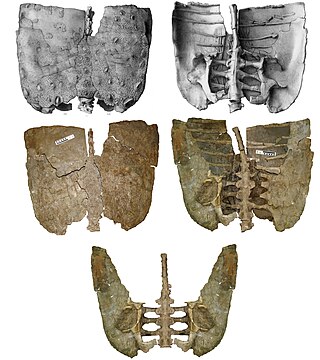
Polacanthinae is a subfamily of ankylosaurs, most often nodosaurids, from the Late Jurassic through Early Cretaceous of Europe and potentially North America and Asia. The group is defined as the largest clade closer to Polacanthus foxii than Nodosaurus textilis or Ankylosaurus magniventris, as long as that group nests within either Nodosauridae or Ankylosauridae. If Polacanthus, and by extent Polacanthinae, falls outside either family-level clade, then the -inae suffix would be inappropriate, and the proper name for the group would be the informally defined Polacanthidae.

Nodosaurinae is a subfamily of nodosaurid ankylosaurs from the Cretaceous of Europe, North America, and South America. The group is defined as the largest clade containing Nodosaurus textilis but not Hylaeosaurus armatus, Mymoorapelta maysi, or Polacanthus foxii, and was formally named in 2021 by Madzia and colleagues, who utilized the name of Othenio Abel in 1919, who created the term to unite Ankylosaurus, Hierosaurus and Stegopelta. The name has been significantly refined in content since Abel first used it to unite all quadrupedal, plate-armoured ornithischians, now including a significant number of taxa from the Early Cretaceous through Maastrichtian of Europe, North America, and Argentina. Previous informal definitions of the group described the clade as all taxa closer to Panoplosaurus, or Panoplosaurus and Nodosaurus, than to the early ankylosaurs Sarcolestes, Hylaeosaurus, Mymoorapelta or Polacanthus, which was reflected in the specifiers chosen by Madzia et al. when formalizing the clade following the PhyloCode. The 2018 phylogenetic analysis of Rivera-Sylva and colleagues was used as the primary reference for Panoplosaurini by Madzia et al., in addition to the supplemental analyses of Thompson et al. (2012), Arbour and Currie (2016), Arbour et al. (2016), and Brown et al. (2017).

This timeline of ankylosaur research is a chronological listing of events in the history of paleontology focused on the ankylosaurs, quadrupedal herbivorous dinosaurs who were protected by a covering bony plates and spikes and sometimes by a clubbed tail. Although formally trained scientists did not begin documenting ankylosaur fossils until the early 19th century, Native Americans had a long history of contact with these remains, which were generally interpreted through a mythological lens. The Delaware people have stories about smoking the bones of ancient monsters in a magic ritual to have wishes granted and ankylosaur fossils are among the local fossils that may have been used like this. The Native Americans of the modern southwestern United States tell stories about an armored monster named Yeitso that may have been influenced by local ankylosaur fossils. Likewise, ankylosaur remains are among the dinosaur bones found along the Red Deer River of Alberta, Canada where the Piegan people believe that the Grandfather of the Buffalo once lived.

Struthiosaurini is a clade of nodosaurid ankylosaurs from the Cretaceous of Europe and North America. The group is defined as the largest clade containing Struthiosaurus austriacus, but not Nodosaurus textilis or Panoplosaurus mirus, and was named in 2021 by Madzia and colleagues for the relatively stable group found in many previous analyses. Struthiosaurini includes not only the Late Cretaceous European Struthiosaurus, but also the Early Cretaceous European Europelta, the Late Cretaceous European Hungarosaurus, and Stegopelta and Pawpawsaurus from the mid Cretaceous of North America. The approximately equivalent clade Struthiosaurinae, named in 1923 by Franz Nopcsa was previously used to include European nodosaurids, but was never formally named following the PhyloCode, so Madzia et al. named Struthiosaurini instead, as the group of taxa fell within the clade Nodosaurinae, and having the same -inae suffix on both parent and child taxon could be confusing in future. The 2018 phylogenetic analysis of Rivera-Sylva and colleagues was used as the primary reference for Struthiosaurini by Madzia et al., in addition to the supplemental analyses of Arbour et al. (2016), Brown et al. (2017), and Zheng et al. (2018).





















